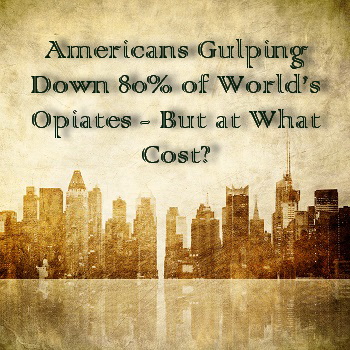Americans Gulping Down 80 Percent of World’s Opiates
Across the U.S., public school health classes and counselors continue to teach about the dangers of drugs like alcohol and cocaine. In the last few years, however, students have begun to learn about what public health officials are identifying as a much larger problem: prescription drugs.
Last year, the pharmaceutical industry released a statement saying that 4.02 billion prescriptions were written in the U.S. in 2011. This comes out to about 13 prescriptions for every American, an all-time record in the U.S. But are all these prescriptions fueling the current prescription drug addiction and overdose rates?
The Statistics
- U.S. doctors wrote 4.02 billion drug prescriptions in 2011.
- According to the CDC, nearly half of the U.S. population has taken at least one prescribed drug during the last month, and more than 20 percent of the U.S. population has taken three or more.
- More than 75 percent of doctor office visits involve prescription drugs.
- More Americans die from prescription overdose than from cocaine and heroin combined.
- Since 2008, more Americans die from prescription overdoses than from car accidents every year.
- In 2011, 16,500 Americans died from prescription painkillers alone.
- Since 2000, the number of prescription overdoses has more than doubled among men, and more than quadrupled among women.
- Americans consume 80 percent of opiate painkillers produced worldwide.
- An estimated 36 million “serious adverse reactions” to prescribed medications in the U.S. every year.
A Growing Epidemic
The dramatic rise of drug prescriptions written every year in the U.S. seems to mirror the alarming rise of prescription drug overdoses, and many experts, including doctors and public health officials, are looking at the issue more seriously. These drugs are very beneficial, but at what cost? Some of the more popular prescribed drugs happen to be some of the most familiar, appearing in magazine, radio and television ads across the country. A recent report released by a London medical journal states that for every $1 spent on researching a particular drug, an additional $19 is spent on promotion and marketing.
The Country’s Most Popular Prescribed Drugs
The numbers of prescriptions written have risen for many drugs across the board in the last decade, and certainly in the last several years. Note that many of the county’s best sellers are not often involved in many overdose deaths (with the exception of hydrocodone). As of 2010, the most popular prescribed medications include:
- Hydrocodone (opiate combined with acetaminophen/Tylenol): pain reliever
- Zocor: drug treating high cholesterol
- Lisinopril: drug treating blood-pressure
- Synthroid: synthetic thyroid hormone
- Norvasc: drug treating blood-pressure
In 2011, the figures changed somewhat, with the anti-depressant Zoloft taking the top slot, followed by the cholesterol medication Lipitor. Sales of drugs treating attention-deficit hyperactivity disorder also jumped, rising 17 percent from 2010.
Most Dangerous Prescribed Drugs
As fatal prescription drug overdoses continue to climb, scientists have been focusing their research on the main drivers behind the epidemic, trying to find which drugs are most likely to cause harm. Opiate painkillers, with their powerful addictive and sedative properties, continue to top the charts and include popular painkillers like OxyContin, Hydrocodone and Vicodin. However, doctors have been aware for some time that taking multiple prescription medications heightens the risk of an overdose.
Medical News Today, for example, reports that many reported fatal overdoses have involved multiple prescription drugs or alcohol. A group of anti-depressants known as benzodiazepines (which includes brand names such as Xanax, Valium and Ativan) seem to be a major contributor, and are involved in about 30 percent of opiate painkiller deaths. This is the first study to point toward a particular group of medications as a dangerous combination with opiates. The danger of alcohol in conjunction with opiates, however, is very well documented.
Of all prescription overdose deaths in the U.S., the ones most commonly involved, alone or in combination with others, are listed below:
- Opioid painkillers: found in about 75 percent of overdoses
- Benzodiazepines: found in about 30 percent of overdoses
- Anti-depressants: found in about 17 percent of overdoses
- Drugs for epilepsy and Parkinson’s: found in about 8 percent of overdoses
The Industry’s Response
The pharmaceutical industry greeted the latest numbers on written prescriptions with enthusiasm. After all, it’s a sign that the industry is growing. When confronted about the alarming rise in prescription drug deaths, manufacturers like Purdue have so far responded with statements about their labeling practices and commitment to working with government officials.
Medical News Today has pointed to unethical online pharmacies as part of the problem. It’s true that recent studies show a link between Internet access and an increase in prescription drug abuse, but doctors are still wary, stating that more studies need to be done. Most likely, online pharmacies (like some corrupt pharmacies elsewhere) comprise just one of many venues that addicts use to get their drug of choice.
Perhaps simply stating that patients and doctors need better communication, or that patients need to read labels more carefully, isn’t enough to combat the problem. After all, Americans consume 80 percent of the world’s supply of opiate medication every year—does this really mean Americans are in more pain than everyone else, or is this a reflection of a broader problem? Whether or not the pharmaceutical industry has any responsibility in the rise of overdose deaths, the problem remains and affects everyone, from preteens to the elderly. Unlike the scary drugs we all learned about in school, these drugs are used and abused by almost every demographic. Complicating the issue even further, these same drugs also help save and improve lives. The question now should be: how do we lower abuse and fatality rates of prescription drugs without restricting access to the patients who really need them? It really is a tough question to answer.




